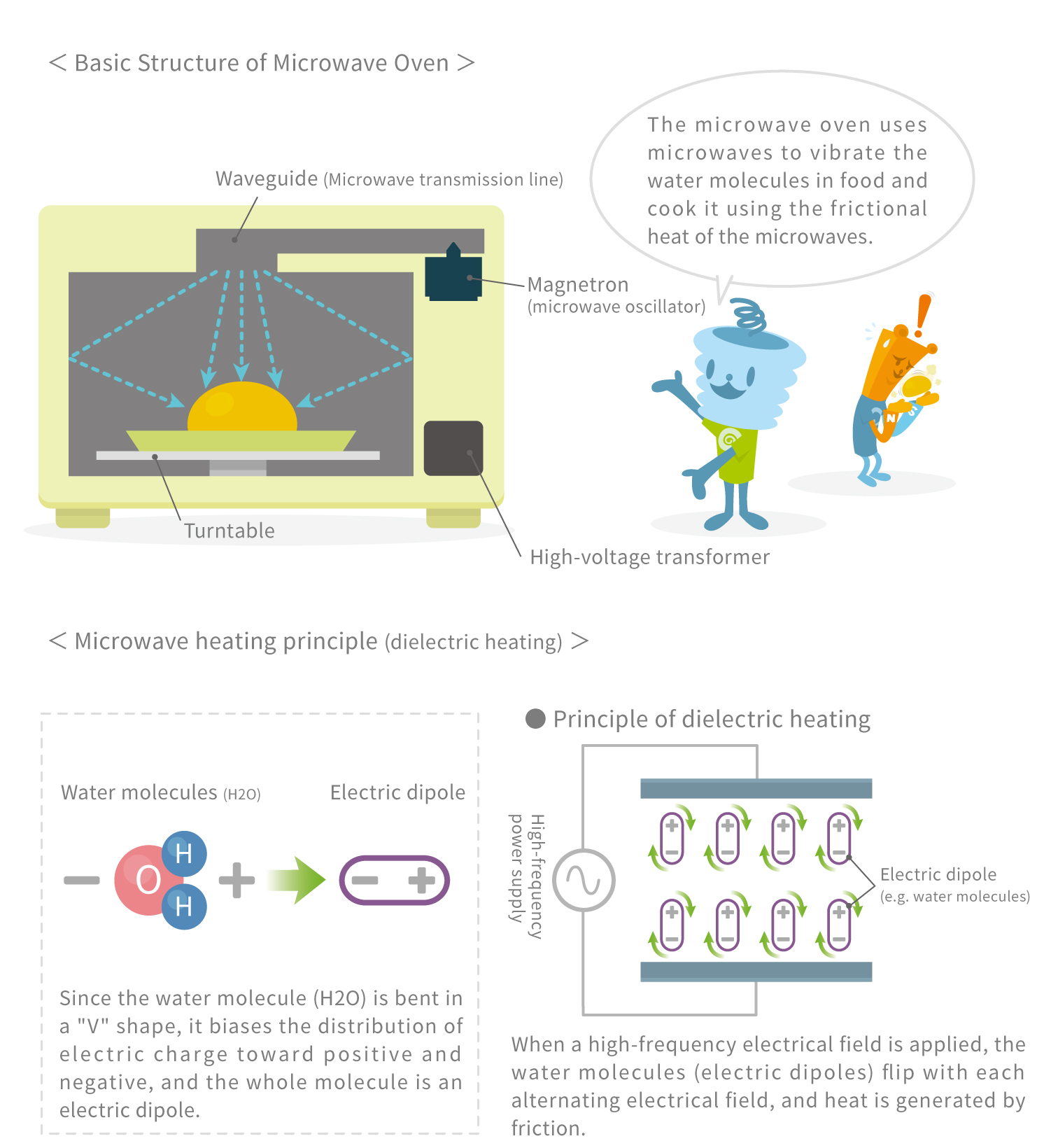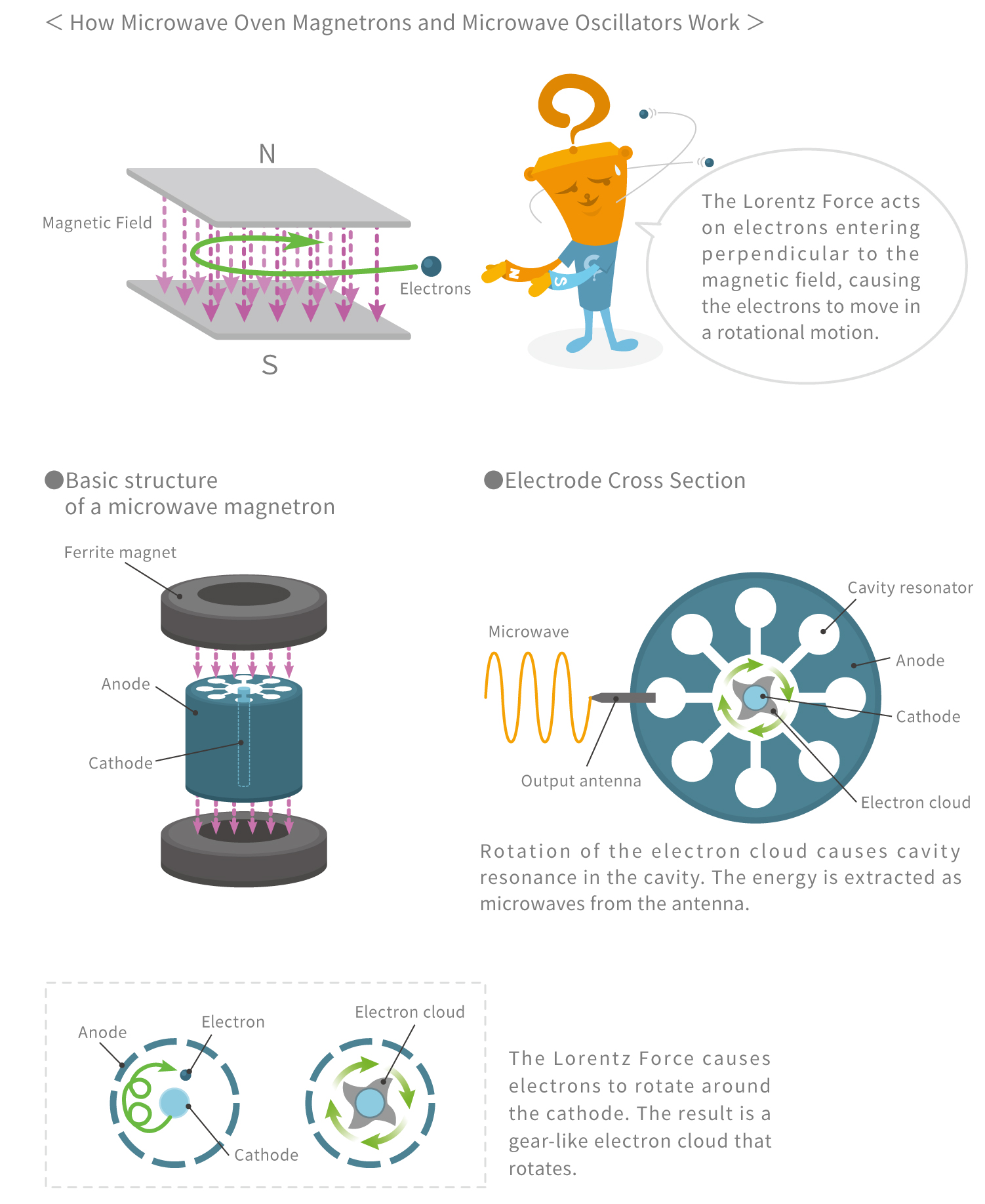The Wonders of Electromagnetism
How Does a Microwave Oven Work? Explaining the Principle of Heating and Basic Structure

Microwave ovens have reached nearly 100% household penetration in Japan. The microwave oven is a cooking appliance developed in the U.S. borrowing from radar technology and advanced by Japanese technology. Its heating method, which uses high-frequency electric fields, is also used for gluing wood and drying food.
The principle of microwave heating
For a long time, electric cookers and electric ovens have been using heating elements such as Nichrome wire. While, electromagnetic cookers and microwave ovens do not use heating elements. For example, Induction cookers use Joule heating, or "induction heating," based on eddy currents generated in metals such as iron pots and pans by high-frequency coils. Microwave ovens, on the other hand, use a different method called "dielectric heating".
The temperature of an object is determined by the degree of vibration of its constituent particles (molecules, atoms, etc.). Heating increases the temperature because the vibrations of the particles become more intense. The microwave oven heats food by causing the water molecules in the food to vibrate at microwave frequencies (2.4 GHz). The water molecule, represented by the chemical formula H2O, has a "V" shaped folded structure with the oxygen atom O at its center. The charge distribution of the entire molecule is therefore an electric dipole with a slight positive and negative bias. Once a high-frequency electrical field is applied to these water molecules, they rotate and vibrate in response to the reversal of the electrical field and generate heat by friction with each other. This is dielectric heating in microwave ovens. Simply put, water molecules absorb microwave energy. This is the reason when it rains heavily, broadcast satellites do not display well, because the raindrops are absorbing microwaves.
The inside of a microwave oven is coated with a metal such as stainless steel for reflecting radio waves well and shielding to prevent radio wave leaks. Radio wave leakage may cause interference with radio waves of wireless LAN (IEEE802.11b/g products). If you experience a disconnection of the wireless LAN or slow communication speed every time you use the microwave oven, you should suspect a problem with the microwave oven.

Precautions for heating food in the microwave
We mentioned earlier that microwave ovens heat food by vibrating the water molecules in the food with microwaves. Therefore, special attention must be taken when heating root vegetables and dried foods that contain little or no water, due to the possibility of ignition. Eggs and chestnuts that have shells, and squid and sausage that have membranes should also heat with caution. Microwaves may cause the water inside to expand, putting pressure on the shell or membrane, causing it to break. Eggs should be cracked open, and squid and sausage should be heated with a slit cut in the membrane to allow a path for water vapor to escape. Care should also be taken when heating liquids such as drinks, curries, and soups. Overheating these liquids could cause an unexpected boil. Normally, a liquid boils at its boiling points, but that is not necessarily depending on the composition of the liquid and heating conditions. By setting the appropriate heating time and output power you can prevent the liquid from a sudden boil.
Mechanism of microwave oven magnetron and microwave oscillation
The microwave oven is an outlandish cooking device that was accidentally born from radar technology. Radar technology, developed in England in the 1930s, was later advanced in the United States during World War II. The microwave oven – invented in 1946 just after the war – is said to have been developed by an engineer from a radar manufacturer, getting the idea from candy in his pocket that had melted when he was exposed to radar radio waves.
Radar technology originally began with the study of the ionosphere, which affects radio communications. In the course of emitting the radio waves into the sky and observing the reflected waves, it was eventually discovered that aircraft could also reflect these radio waves. During World War II, anti-aircraft radar was developed to detect enemy aircraft and it was found that aircraft detection required radio waves with shorter wavelengths. Thus, an electron tube that emits microwaves (approximately 1 to 10 cm in wavelength) was developed and this tube is called a magnetron. The magnetron is also the heart of the microwave oven.
A magnetron is a special bipolar vacuum tube to which a magnetic field is added by using a magnet. The Lorentz Force acts on electrons moving in the magnetic field, bending their orbits. By applying an external magnetic field to the electrode structure of the dipole vacuum tube, the electrons emitted from the cathode do not reach the anode, but instead orbit around the cathode in a rotational motion. This vibration resonates in a cavity on the anode side, and the magnetron extracts the energy as radio waves from the antenna. The first magnetron invented by Hull in the U.S. (1916), but it was Japan's Kinjiro Okabe (1927) who paved the way for microwave oscillation with the idea of a split anode.

Dielectric heating for drying wood and food products
The world's first microwave oven was sold in the United States in 1947. Initially, however, they were expensive and large devices, used only in a few restaurants. What contributed to the widespread use of microwave ovens was the miniaturisation and low price of the magnetron. This was mainly due to the technology of Japanese manufacturers. The use of ferrite magnets in place of alnico magnets contributed greatly to lower the prices, and microwave ovens rapidly became popular in the 1970s.
Before the spread of microwave ovens, dielectric heating using high frequency waves had been used in industrial fields, such as wood drying and gluing. For instance, dielectric heating under reduced pressure can dry thick square timbers in a short time. Thick special plywood, for example, is glued together with adhesive and then placed between parallel electrodes, where it is heated and glued together by the high-frequency electrical field from the electrodes. Dielectric heating is also used for gluing laminated wood such as wooden dining tables, which are made by joining long, thin pieces of square timbers and boards together. Depending on the arrangement of the electrodes, it is possible to selectively heat only certain parts of the laminated wood.
"Mage-wappa", a traditional woodcraft created in Akita Prefecture, is made by soaking thin boards of cedar or cypress in hot water to make them bend easily. Dielectric heating generates high-temperature steam inside the wood, which has the same effect as boiling, making it easier to bend thicker pieces of wood.
In Japan, dielectric heating is used not only for wood processing but also for drying tea and textiles. In our daily lives, dielectric heating is what we greatly rely upon.

TDK is a comprehensive electronic components manufacturer leading the world in magnetic technology






